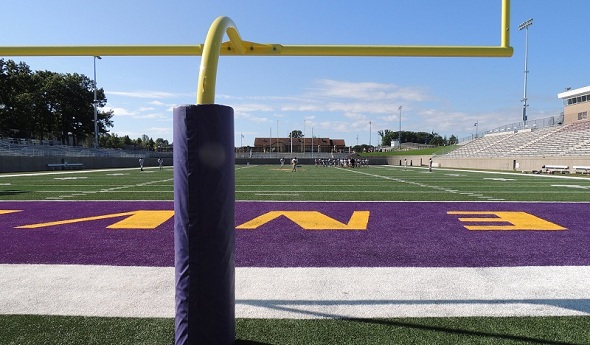
A Legacy Begins in Greenville
August 24, 2012
By Geoff Kimmerly
Second Half editor
GREENVILLE – Curtis Heppe has no idea what to expect, but a few guesses and a dream or two of how it will feel tonight to lead his teammates into Greenville's Legacy Field for the first time.
“It’s going to be electric, for sure. It’s a new vibe. It’s high-tech there,” the Yellow Jackets quarterback said Thursday after his team’s final preseason practice.
Those expectations are shared by a community that will be cheering on the local team in a new home after nearly a century at the legendary Black Field.
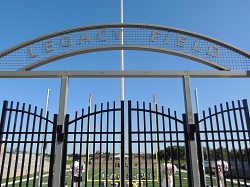 Workers put the finishing touches on the near-$7 million facility this week in advance of the season's first varsity game, tonight against rival Belding. Legacy Field officially opened for Wednesday’s freshman game, and Heppe said that even for that lower-level appetizer, the stadium began to come alive.
Workers put the finishing touches on the near-$7 million facility this week in advance of the season's first varsity game, tonight against rival Belding. Legacy Field officially opened for Wednesday’s freshman game, and Heppe said that even for that lower-level appetizer, the stadium began to come alive.
“We’ve just wanted Friday night to come. To get in and see how intense, how nice this place is,” he said. “Coming out of that tunnel, seeing our fans, it’s going to be the best feeling.”
Tonight’s grand opening will be the culmination of efforts from not just administrators, but students and community members as well – down to the name of the stadium itself.
“Legacy Field” was selected by Greenville’s school board. But it came as a suggestion from the school’s student council, which took submissions from classmates and then with faculty and administrators whittled the list to three favorites – Stinger Stadium and Community Field were next on their list.
But that’s just one way Legacy Field is a blend of old and new and ideas from all over town.
“In development, (it’s been) probably 10 years. We’ve been talking about it ever since I’ve been here, that one day we’d be able to do this,” said Greenville athletic director Brian Zdanowski, who is entering his 15th school year at that post. “It came through strategic planning. It came through community input. And then ultimately, our board bought in that there was enough interest in the community.”
Deeply rooted
A walk through Legacy Field is a history lesson. But first, an explanation of the Yellow Jackets’ past.
Black Field had served as the team’s home since 1916. It is nestled downtown next to Greenville’s former high school, which is now a library.
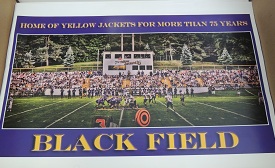 The current high school, about 1.5 miles northwest, was built in 1963. Football teams continued to make the short trip for home games.
The current high school, about 1.5 miles northwest, was built in 1963. Football teams continued to make the short trip for home games.
Black Field has its charms. With no track surrounding the field like at many multi-purpose stadiums, fans are only a few yards from the sideline. And all of that history added to the mystique for the latest players to wear the uniform.
The field also has had peculiarities. Zdanowski said at one point, the end zones were elevated in the corners. And the field wasn’t always square – a 10-yard penalty might measure 11 on one side of the field but only nine yards on the other.
But after just about every home game, students met for a bonfire on the grounds, an extension of the celebration by neighborhoods that surround Black Field and embraced the team for decades.
“It was the typical focal point of the community,” Zdanowski said.
Some things old, many new
Playing on Black Field was special, Heppe added. But he's equally if not more excited to be part of this new legacy. And architects made sure to bring that community feel to the new home this fall.
Destruction and construction began May 2, the day after last season’s final girls tennis match. The courts formerly sat in what is near the south end zone, and were moved closer to the track and soccer facility.
Amenities at the Yellow Jackets’ new football home are comparable to a college stadium’s, starting at the north side of the field.
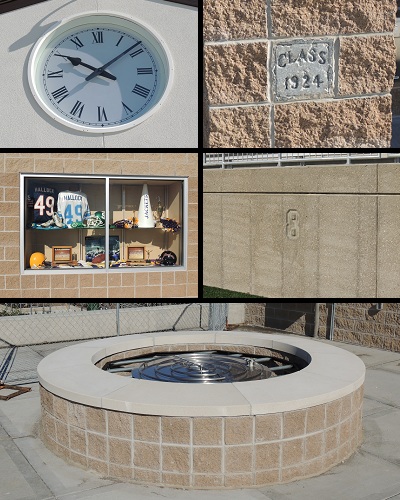 Players will enterthrough a tunnel that pours into the field like that of a miniature Spartan Stadium. Surrounding the tunnel are expansive locker rooms both for the home team and visitors, a similarly expansive training room and officials area and plenty of storage that will allow Greenville’s entire football program to be housed under that one roof. Unlike Black Field, tucked neatly among its neighbors, Legacy Field has plenty of parking and lighting, and builders were able to make that possible while also keeping intact a group of large oak trees near the south gate.
Players will enterthrough a tunnel that pours into the field like that of a miniature Spartan Stadium. Surrounding the tunnel are expansive locker rooms both for the home team and visitors, a similarly expansive training room and officials area and plenty of storage that will allow Greenville’s entire football program to be housed under that one roof. Unlike Black Field, tucked neatly among its neighbors, Legacy Field has plenty of parking and lighting, and builders were able to make that possible while also keeping intact a group of large oak trees near the south gate.
The turf is synthetic, like that played on by all but one member of the Yellow Jacket’s O-K Bronze conference. The difference from many is that the field has been dug out from the surrounding property, making it even more a focal point for those who will occupy the roughly 4,000 seats in the surrounding cement bowl. (The removed dirt was used to build two Little League fields on another part of the property.)
The sound system is of course state-of-the-art, and the press box, concessions area and restrooms also are equally expansive. But what locals should notice most are the throwbacks to the past that dot every corner of their new home.
Cut into the brick work near the concession counter is a block from Black Field that had been dedicated by the school’s class of 1924. Atop the building is the Centennial Clock, 100 years old this year, which formerly hung at the entrance the old school and was donated by the class of 1912. It has been housed by Greenville’s museum until being re-donated to the school district to become part of the stadium.
Molded into the cement walls on the west and south sides of the field are the numbers formerly worn by players Henry Loding and Greg Blumberg. Both died from football-related injuries; Loding in 1906 and Blumberg in 1977. Two trophy cases are cut into the stone on the facing of the press box, including one featuring mementos celebrating alum and former Detroit Lions tight end Ty Hallock.
Another addition of historical significance will come later. The school’s first Hall of Fame class will be inducted before the Sept. 7 game, and that display will be housed near the south ticket area so residents and fans can check it out without having the enter the stadium itself.
And one last thing was added to keep with tradition. To the west of the concession area, but within the stadium fence, sits a large gas fire pit for those postgame gatherings – plus a sound system where students can plug in their mp3 players.
“We said we’re not forgetting our past, but we’re embracing our future,” Zdanowski said. “I’m sure a lot of people have said that before. So we really wanted to make sure we got community input on it and do as much as we could to replicate Black Field. … And I think we won some people over. We really wanted to do what we said (we’d do).”
PHOTOS: (Top) Greenville's junior varsity ran through drills during a morning session at Legacy Stadium, which opened this week. (Top middle) The ticket area and gate for fans sit on the south side of the field. (Middle) A poster given out last season celebrated the final to be played at Black Field. (Bottom middle) A number of pieces of Black Field's past and Greenville tradition were brought over to or included in Legacy Field, including Centennial Clock, which formerly was part of the old school.
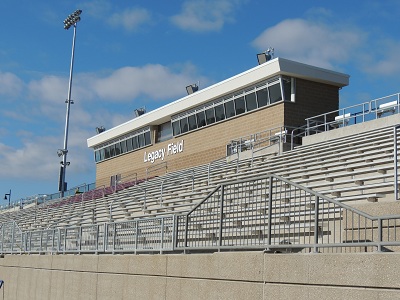
Legacy Field's press box is split into areas for game workers, coaches and media with a roll-up door for film crews.
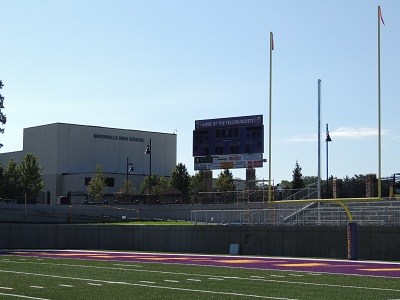
Legacy Field sits between Greenville's high school and middle school and adjacent to its soccer and track facilities.
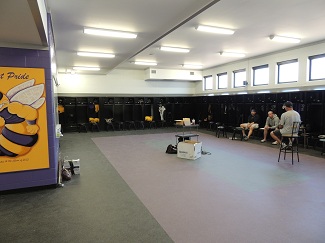
Coaches met in the spacious varsity locker room Monday morning. Junior varsity and freshman locker rooms are connected by a hallway with access to storage areas and the coaches' office.
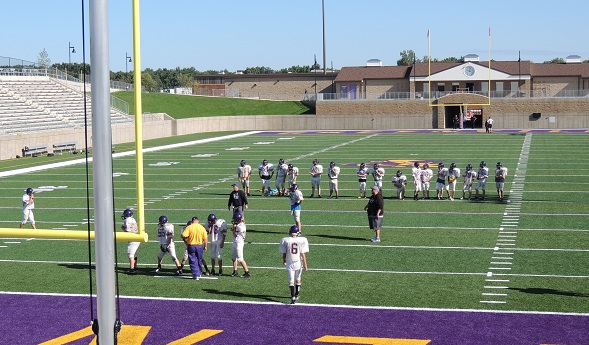 Players will enter Legacy Field through a tunnel at its north end. Above sits the concession area and restrooms, and the Centennial Clock that once ticked in the old Greenville school.
Players will enter Legacy Field through a tunnel at its north end. Above sits the concession area and restrooms, and the Centennial Clock that once ticked in the old Greenville school.
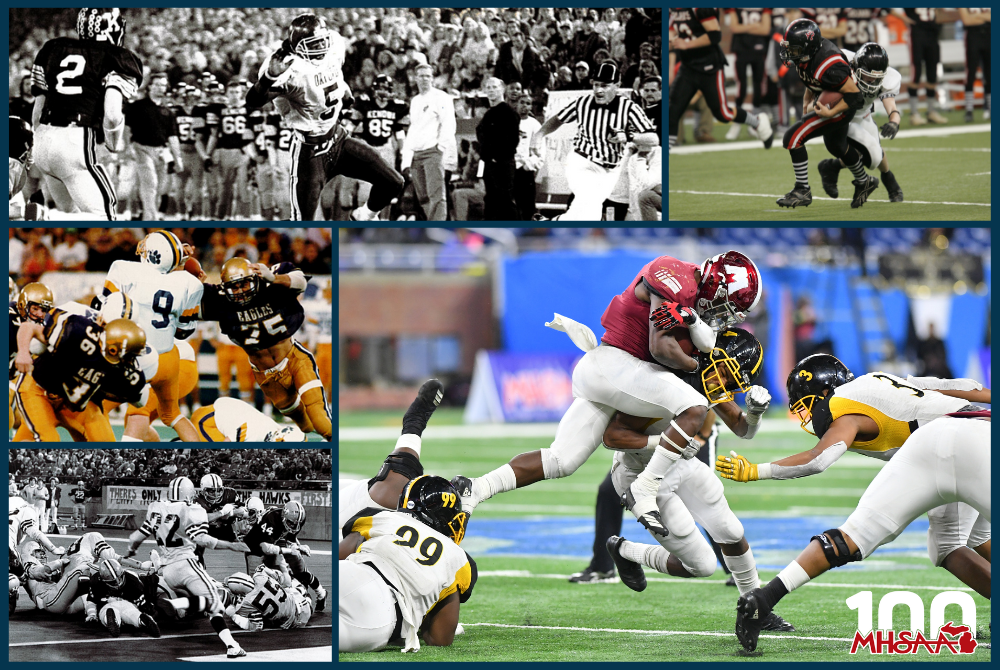
Century of School Sports: Fall to Finish with 50th Football Championships
By
Geoff Kimmerly
MHSAA.com senior editor
September 4, 2024
We’ve only just begun to celebrate the MHSAA’s 100th anniversary – a “Century of School Sports” dating back to our start Dec. 13, 1924.
This celebration just happens to coincide with another major milestone this fall – the 50th season of MHSAA Football Playoffs.
After decades of football champions being determined by media polls, the MHSAA offered its first postseason for football in 1975 – 16 teams qualified to compete across Class A, B, C and D. Livonia Franklin, Dearborn Divine Child, Ishpeming and Crystal Falls Forest Park, respectively, hoisted those first championship trophies.
The first year’s Finals were played at Central Michigan University and Western Michigan University, two games at each site, before moving to the Pontiac Silverdome the following season – the home for MHSAA football championships until their move to Ford Field in 2005.
Meanwhile, the playoff field grew to 32 teams – eight per class – in 1977, and again to 64 teams over four classes in 1985. Classes AA, BB, CC and DD were added in 1990, bringing the number of 11-player football championships to its current eight. The 11-player field and format expanded one more time in 1999, doubling to 256 teams total – 32 per division – with a fifth week of postseason games bringing the playoff schedule to its current five weeks.
As more small schools began to have difficulty sustaining their programs during the first decade of the 2000s, the 8-player format began to grow with the first playoffs for that division in 2011. The 8-player bracket was split into two divisions in 2017.
Football remains the most played sport in this state, and its playoffs the most attended MHSAA postseason tournament. As of this writing, an estimated 35,000 athletes representing 601 varsity teams are vying for championships this 2024 season. This year's Finals are Nov. 23 for 8-player and Nov. 29-30 for 11-player.
Now, for the fun facts:
- A total of 24 teams have qualified for the MHSAA Football Playoffs at least 30 of the first 49 seasons. Beal City and Crystal Falls Forest Park lead the way with 38 qualifying seasons, followed by Mendon with 37 and Fowler and Traverse City St. Francis with 36. Forest Park and Mendon’s totals include appearances in both the 11 and 8-player brackets. Farmington Hills Harrison remains tied for seventh on the list with 34 postseason appearances despite closing at the end of the 2018-19 school year. NOTE: The totals above do not include the 2020 season, when all schools were entered into the tournament as the regular season was shortened due to COVID-19.
- Rockford has the longest overall and active streaks of qualifying for the playoffs at 28 straight seasons, again not counting 2020 when all teams were added to the bracket. Forest Park at 26 seasons, Jackson Lumen Christi at 25 and Muskegon at 23 seasons are the next four on the overall and active streak lists (Muskegon is tied on the overall list with Felch North Dickinson’s run from 1991-2013).
- Farmington Hills Harrison still has the most appearances in 11-Player Finals, with 18, but with Detroit Catholic Central just one back and Lumen Christi with 16. Lumen Christi has won the last two Division 7 titles to move into a tie for the lead on the total 11-player championship list with 13, the same number won by Harrison during its mighty history.
- On the 8-player side, Powers North Central leads with five appearances in Finals and five championships having won all of them.
- The Jets also own the longest championship streak in 8-player, with three straight titles from 2020-22. Grand Rapids West Catholic from 2013-17, Harrison from 1997-2001 and East Grand Rapids from 2006-10 all have won five 11-player championships in a row, with eight more 11-player programs having won at least three consecutive titles.
This is but a glance at the playoffs’ past. MHSAA historian Ron Pesch has written several exceptional pieces on the MHSAA Football Playoffs for MHSAA.com, and these are a few of our favorites:
- “Culmination of Ideas, Cooperation Lead to Creation of MHSAA Football Playoffs”
- “Farwell Silverdome; Our Memories Live On”
- “Football Finals: Top 10 of the first 15 Years”
You also can check out a list of all-time playoff qualifiers and 11 and 8-Player Finals records by visiting the MHSAA Football Record Book.
Previous "Century of School Sports" Spotlights
Aug. 28: Let the Celebration Begin - Read
PHOTOS Clockwise from top left: (1) Oxford’s Carl Reaves (5) breaks a tackle during Oxford’s 20-13 overtime win over Grand Rapids Kenowa Hills in Class BB in 1992. (2) A Crystal Falls Forest Park ball carrier is wrapped up by a New Lothrop tackler during New Lothrop’s 34-13 win in Division 8 in 2006. (3) Muskegon and Detroit Martin Luther King players collide during the Crusaders’ 41-25 victory in Division 3 in 2018. (4) Schoolcraft’s Paul Garrison (75) applies the pressure during his team’s 42-7 win over Frankfort in Class D in 1988. (5) A Farmington Hills Harrison ball carrier pushes toward the end zone against Midland Dow in 1976; Dow would prevail 36-27.

